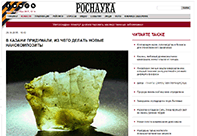Research Highlights 2009-2015

Our research is highlighted in national and international media sources
| Nanowerk Yuri Lvov and Rawil Fakhrullin of Bionanotechnology Lab, Kazan Federal University, in cooperation with Wencai Wang and Liqun Zhang of State Key Laboratory of Organic-Inorganic Composites, Beijing University of Chemical Technology have recently presented in Advanced Materials a broad scope of application of halloysite clay tubes. |
| EurekAlert Scientists have recently presented a broad overview of halloysite clay tubes. |
| Science Newsline Medicine Halloysite: Finally a promising natural nanomaterial? A research group of scientists from Kazan Federal University and Beijing University of Chemical Technology have recently presented a broad overview of halloysite clay tubes. |
| ECN Scientists from Kazan have recently presented in Advanced Materials a broad scope of application of halloysite clay tubes. |
| Nanotechnology Now Halloysite: Finally a promising natural nanomaterial? Read a new Advanced Materials article "Halloysite Clay Nanotubes for Loading and Sustained Release of Functional Compounds". |
| Med Device Online A research group of scientists from Kazan Federal University and Beijing University of Chemical Technology have recently presented a broad overview of halloysite clay tubes. |
| R&D Scientists from Kazan University have reported Halloysite as a promising natural material. Halloysite is a natural biocompatible nanomaterial available in thousands of tons at low price, which makes it a good candidate for nanoarchitectural composites. |
| Scicasts Halloysite Reported as Promising Natural Nanomaterial. |
| AZoNano An overview of the range of useful applications of halloysite clay tubes has been published. The naturally occuring, biocompatible, nanoscale tubes can be used for sustained drug delivery and alongside enzymes as biocatalytic nanoreactors. |
| Materials Today A team from Kazan Federal University in Tatarstan and Beijing University of Chemical Technology has published a new study on halloysite clay tubes that shows their potential as a safe natural biocompatible nanomaterial that is abundantly and cheaply available and therefore able to be scaled-up for production. |
| Nanotechnology Now Halloysite: Finally a promising natural nanomaterial? A research group of scientists from Kazan Federal University and Beijing University of Chemical Technology have recently presented a broad overview of halloysite clay tubes. |
| Роснаука Kazan scientists invented what to make new nanocomposites from. |
| InnovaNews.ru Kazan scientists have published a study in Advanced Materials on the various applications of halloysite clay nanotubes. |
| Дело Жизни "Smart" drugs are something that is increasingly being talked about in Russian and world medicine. The "nanodelivery" of drugs is discussed in an interview to a medical journal. |
| КФУ: вчера сегодня завтра Whether KFU scientists can control the effects of drugs in the body, and what steps are being taken to create human tissues? The achievements of Russian medicine are discussed in the program of university television. |
| Environmental Science: Nano blog Professor Fakhrullin and colleagues at Kazan Federal University investigated for the first time the in vivo toxicity of HNT using Caenorhabditis elegans nematode as a model organism. The results suggest that these are potentially environmentally safe materials to work with. |
| Телеканал Россия Культура Our lab was featured by one of the Federal TV channels (Culture) (in Russian). |
| ПОИСК.Еженедельная газета научного сообщества № 18 (2013) Cyborgs inside us? Modified cells will become a formidable force in the fight against dangerous diseases. |
| Kazan University The article by employees of the Institute of Fundamental Medicine and Biology at KFU in the British journal Nanoscale was included among the "hot articles" of the week and announced in the journal's social networks. |
 | Kazan University Researchers of the Institute of Fundamental Medicine and Biology at KFU talk about the latest developments of the Laboratory of bio- and nanomaterials. |
| Nanowerk A Perspective paper in the May 21, 2012 online edition of ACS Nano ("Face-Lifting" and "Make-Up" for Microorganisms: Layer-by-Layer Polyelectrolyte Nanocoating") covers the most interesting and promising work in the area of modifying living cells by coating them with a nanolayer of functional materials in order to provide them with new structural and functional features. |
| ГАЗЕТА.РУ It is not necessary to modify the cell genome to change the properties of cells and make them "dance to someone's tune. “Cyborg cells” could help humans in cell therapy, nanodelivery of drugs, and ferrying bacteria from one planet to another. |
| Троицкий вариант - Наука Biochemists from Kazan Federal University have taken another step in developing "cell therapy" by introducing a method of putting magnetic tags on human injected cells, allowing them to be directed through the body. |
| ACS News Service Weekly PressPac In a discovery that may help speed use of “cell therapy” — with normal cells or stem cells infused into the body to treat disease — scientists are reporting development of a way to deliver therapeutic human cells to diseased areas within the body using a simple magnetic effect. |
| Chemport Scientists from Kazan Federal University talk about modifying the surface of living microscopic worms - nematodes with layers of polyelectrolytes followed by modification of living organisms with biologically compatible magnetic nanoparticles. |
| Chemport A group of scientists created new artificial multicellular organisms called yeastosomes. |
| Chemport An international collaboration between researchers from Russia and Great Britain made it possible to obtain living multicellular structures that can shed light on the evolution of living organisms and can also be applied to produce artificial tissue. |
| Royal Society of Chemistry Chemists have produced living multicellular structures that could show how organisms evolved in nature and be used in tissue engineering. |
| Royal Society of Chemistry A team of Tatar and UK scientists have developed a technique for functionalising yeast cells with magnetic nanoparticles. The cells remain alive after being modified, opening up the possibility of harnessing their magnetic properties for many biotechnological applications. |




































